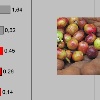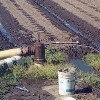 > ENC Master > Climate Encyclopaedia > Food & Climate > basics > 2. The climate change issue > - future food production
> ENC Master > Climate Encyclopaedia > Food & Climate > basics > 2. The climate change issue > - future food production
 |
|
|
|
|
What may happen to food production in the future?
|
|
Biophysical effects of climate change on food production will be positive in some regions, and negative in others, and these effects will vary through time. Socio-economic factors that influence food production are changes in number of people that have to be fed, changes in prices, changes in trade, and possibility of adaptation. Scientists combine different mathematical models (climate, agricultural, and economic models) to project impacts of global change on regional food production. The figure shows the results using the Hadley climate scenario (for further explanation on how this models work, see the "read more" section) for the years 2020, 2050, and 2080. The maps have to be interpreted remembering that the results depend on: climate, CO2 effects on the crop, and changes in socioeconomic conditions and technical improvements. For example in more developed countries, lower rainfall can be compensated by developing irrigation systems, while this is not possible in less developed countries. |
|
As shown in the maps, the increased temperatures in many parts of Africa will certainly decrease food production. The reduction of precipitation in Australia will also be negative for crops that can be compensated in some cases by irrigation. The increase in precipitation combined with a moderate increase in temperatures in North America may benefit food production in that region. The maps show that the burden of climate change may fall disproportionately in the poorer countries.
|
Factors influencing future food production:Scientists always stress, that predicting the future is very difficult, for the food production even more than for climate change. Click on the thumbnails below in order to understand what factors have to be taken into account and how the situation can differ a) in developing countries |
|
|
|
|
|
Image sources for the figure series: |
Author: Marta Moneo and Ana Iglesias- Universidad Politécnica de Madrid - España |











